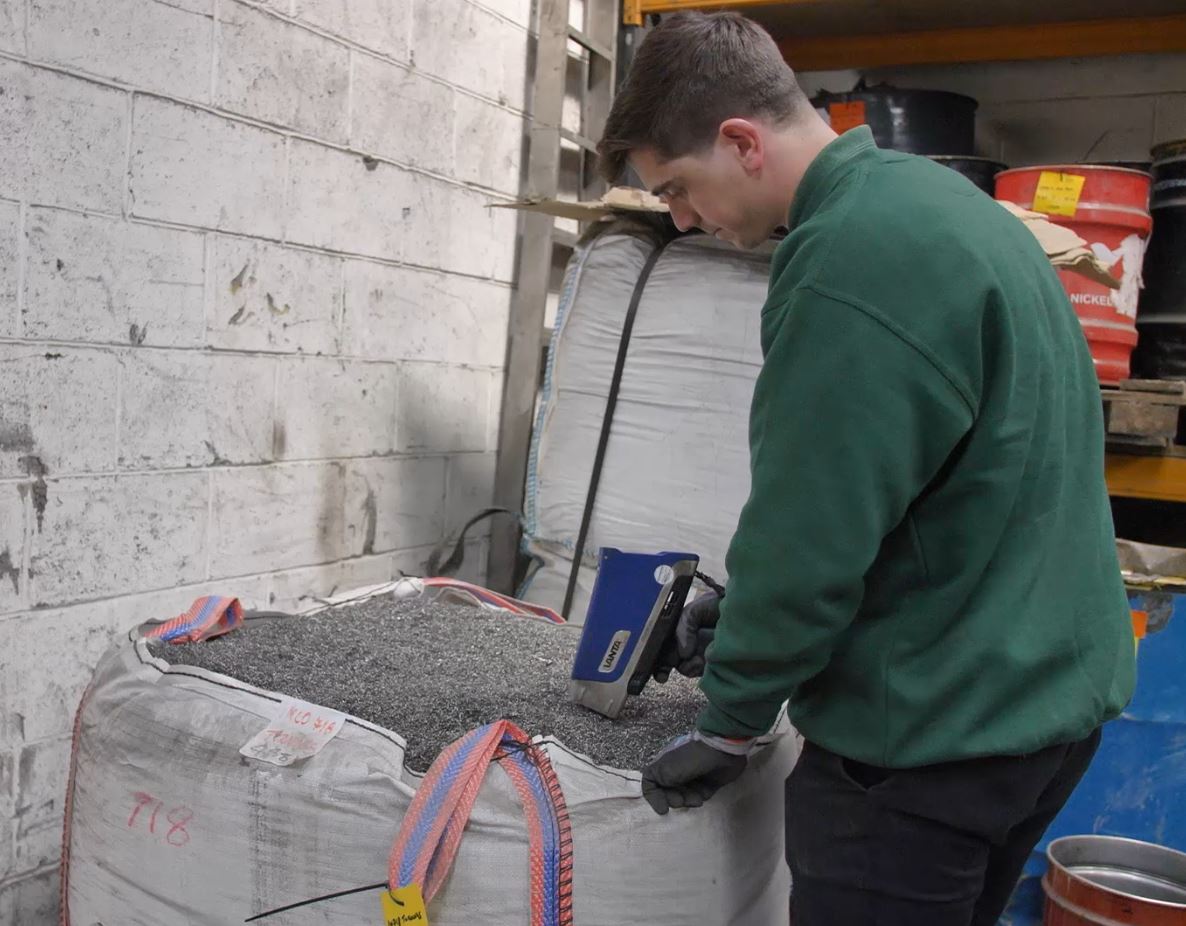Peak Alloys is a trader and processor of high-value nickel- and cobalt-based superalloys in Sheffield, United Kingdom. The company supplies fully processed scrap to vacuum-melt and air-melt alloy producers around the world. To make sure their products meet customer demands, they have invested in Olympus’ handheld X-ray fluorescence (XRF) equipment—one DELTA™ analyzer and two Vanta™ analyzers—to test the elemental composition of materials.
We recently visited Peak Alloys to learn more about their scrap recycling operations. Duncan Birchley, the director and cofounder of Peak Alloys, explained how they use handheld XRF in their process:
“When we receive any goods delivered from our suppliers, they come on site, are visually identified, checked, weighed, and lotted up with unique identification lot numbers. At that point, we 100% test the materials with the XRF guns. Anything that is not suitable goes down the route—maybe for nickel or cobalt refining, for air-melt applications, or, if it is upgradable and suitable for vacuum-melt, then it is kept in a separate pan.”
An operator tests nickel alloys using the Vanta handheld XRF analyzer
Duncan continued, “Material then goes down for further processing to be cut to size, because each customer has a restriction on the size and the form of the material. The attachments are removed if they are present, any coatings are removed—whether it is an abrasive coating or chemical coating.
The material is then sent down for shot blasting to give it a clean surface to remove any potential surface contamination and to give it that cosmetic look. Obviously if it looks nice, and is all gleaming and clean, it is more attractive from the consumer’s point of view.
The material is then packaged into drums, labeled, marked up, ready for dispatch, and out it goes. If samples need to be sent away for batch analysis, we do that, and that accompanies the goods supplied to the customers.”
Speed and Accuracy Provide Confidence in the Scrap Recycling Process
For Duncan, the speed and accuracy of handheld XRF give the operators at Peak Alloys assurance throughout the scrap recycling process.
“We need an XRF that can identify and give us a heads up on what we are looking at to ensure what we are receiving from our customer base is what we are expecting. If any anomalies turn up, then we can investigate those further. Both the DELTA and the Vanta have been extraordinary in what they do,” Duncan noted.

An operator uses the Vanta handheld XRF analyzer to quickly measure alloys
Duncan explained the importance of fast results in scrap sorting and recycling, highlighting how handheld XRF saves them time:
“Without the Olympus equipment, we couldn’t do what we do. In the past, when equipment was tested on bench equipment, on fuses, or on laboratory equipment, you could be taking minutes if not hours to get a reading. The XRF guns speed up everything. As we are 100% testing, it’s very time consuming. Equipment that can help with that time and give us the accuracy that we are looking for is so imperative.”

Operators test alloys throughout the scrap sorting and recycling process
Ruggedness is another benefit. He explained, “Even though we treat everything with respect here, having that confidence or security that if there are slight knocks to the analyzer, there isn’t a massive repair bill.”
Favorite Handheld XRF Features for Scrap Recycling
The Vanta XRF analyzer has an intuitive user interface that makes it easy to navigate the device’s settings and software functions. Duncan highlighted favorite features that help his team stay productive:
1. Grade match
“Usually for type grading, we will do 2 to 3 seconds per test, which really helps it along. Anything a little more involved, we would hold the XRF gun on a little longer to determine the other elements.”
2. Averaging
“When we are doing any testing of mixed materials that are going to go in for maybe nickel refinery, then we will do multi-tests. It will give us the average against that so we that will know what we are supplying to the customer.”
3. Second beam
“We also use the second beam on certain things to determine the light elements and the content of it. Just as a double check on certain alloys, where there are very similar ones—a crossover, where maybe the aluminum is a determining point.”
4. Grade library
“We use the grade library within the XRF gun as well. It really helps determine what alloy or what comparative alloy it could be. All our operators are instructed to not just look at the grade match but to look at the variation number by the side of it. If we are doing a mass test of the same alloy, then we are looking for an exact reading to come up each time. If anything is highlighted as being out of spec, then we will put that to one side and investigate further.”
All in all, the analyzer keeps the team productive with high-throughput testing and accurate results so they can meet customer demands. Learn more about how Peak Alloys uses handheld XRF by watching our interview below:
Related Content
Brochure: Vanta Analyzers for Scrap Recycling
Calculating Your ROI for Scrap Metal Recycling: The Value of Handheld XRF
Scrap Recycling with XRF—Sort More, Sort Faster, and Increase Your Profits
Get In Touch






.jpg?rev=7351)